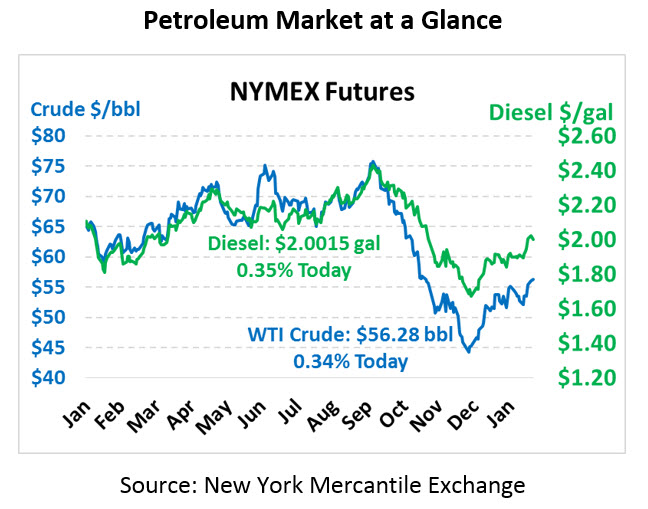
China’s Shale Revolution?
Crude oil set a new multi-month high yesterday, trading mildly higher in conjunction with other financial markets. After some early morning losses, crude oil appears to be continuing its slow march higher. WTI Crude is currently trading at $56.28, up 19 cents from yesterday’s close.
Unlike crude, fuel prices traded lower yesterday, with diesel falling below the $2/gal level established last Friday. This morning, though, both prices are trading higher. Diesel is currently trading at $2.0015, up 0.7 cents from yesterday’s close. Gasoline prices are $1.5797, up 1.6 cents from yesterday’s close.
Contributing to recent price activity, Libyan rebels recently turned the country’s 300 kbpd oil field, El Sharara, back over to the National Oil Company. NOC officials will assess security at the field before resuming operations, but markets are anticipating a fairly quick resumption of production. The field was seized back in December, forcing the NOC to declare force majeure on oil contracts.
In China, a recent oil discovery has sparked speculation that China could be on its way to its own shale revolution. Fracking technology revolutionized American oil production and turned us into an energy powerhouse, and oil experts believe this same technology could be applied to China’s shale fields. Before you get too excited about the prospect of bountiful oil and a return to $1/gal oil prices – the oil discovery is only pumping 733 barrels per day right now. China’s “revolution” would be far less impressive than the one experienced in America. Morgan Stanley estimates that they could reach 200 thousand barrels per day of shale production by 2025 – compared to 8.3 million barrels per day of shale production in the US today.
In contrast to the more bearish news, supporting WTI oil prices today is news that Keystone has partially restarted a segment of its crude pipeline running from Nebraska to Illinois, which had been offline due to a suspected leak. Although the segment is not back to 100% capacity, the restart will alleviate the flow of crude to Cushing (the physical delivery point for WTI crude), removing some of the upward pressure on Cushing crude stocks.
This article is part of Crude
Tagged:
MARKET CONDITION REPORT - DISCLAIMER
The information contained herein is derived from sources believed to be reliable; however, this information is not guaranteed as to its accuracy or completeness. Furthermore, no responsibility is assumed for use of this material and no express or implied warranties or guarantees are made. This material and any view or comment expressed herein are provided for informational purposes only and should not be construed in any way as an inducement or recommendation to buy or sell products, commodity futures or options contracts.






